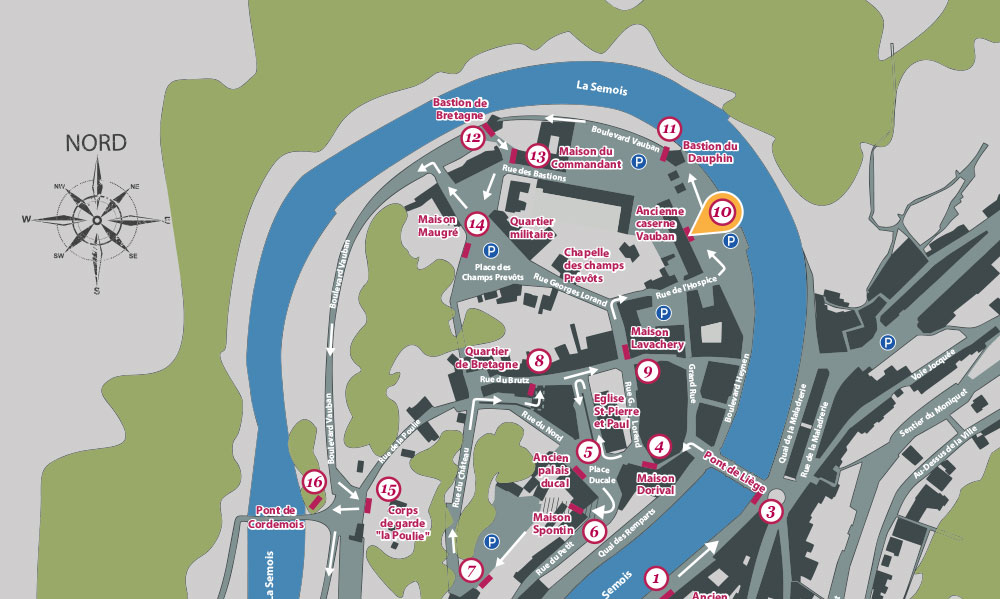10
CASERNE VAUBAN


ANCIENNE CASERNE « VAUBAN »
Exemple remarquablement conservé d’un corps de caserne de cavalerie, ce bâtiment est aujourd’hui le principal vestige de l’ancien quartier militaire édifié par Vauban en 1690, à l’extrémité nord de la ville. Des troupes militaires françaises, hollandaises, puis belges ainsi que leurs montures, - 160 chevaux - pouvaient prendre place dans les écuries du rez-de-chaussée, y séjourneront jusqu’à la suppression de la garnison, en 1865. Ce lieu si spécifique dans la cité conservera cependant son esprit militaire grâce à l’implantation de deux écoles régimentaires qui fonctionneront jusqu’à la première guerre mondiale. Des logements sans confort y seront par la suite aménagés, en même temps que l’Hospice de la Ville. Inscrite dans un programme de réhabilitation du patrimoine dans les années 1990, la Caserne « Vauban » abrite actuellement dix appartements sociaux. Le bâtiment est classé depuis 1978.

DE OUDE KAZERNES VAN VAUBAN
Deze ruiterijkazerne is heden ten dage het belangrijkste overblijfsel van een oud militair kwartier. Het werd in 1690 door Vauban aan het einde van de stad gebouwd. Tot aan de opheffing van het garnizoen in 1865 verbleven er Franse, Hollandse en daarna Belgische militairen met hun rijdieren. Er was plaats voor 160 paarden in de paardenstallen. Dit zo specifieke gedeelte van de stad behield zijn militair voorkomen dankzij de vestiging van twee militaire scholen die er tot aan de eerste oorlog gevestigd waren. Daarna werden er slaapgelegenheden zonder comfort ingericht tegelijkertijd met het stedelijk tehuis. In 1990 werd het in een renovatieplan ingeschreven. Nu zijn er in de kazerne van Vauban tien sociale appartementen. Het gebouw werd sinds 1978 geklasseerd.

OLD « VAUBAN » BARRACKS
These remarkably preserved cavalry barracks are today the main remains of the former military parts of the city built by Vauban in 1690 in the north-east part of the town. The French-, Dutch- and then Belgian troops sojourned there until the disbanding of the garrison in 1865. About 160 horses could stay in the stables. The place kept its military vocation when two military schools were opened and stayed in operation until World War I. The uncomfortable lodgings of the barracks were renovated at the same time as the Town Hospice. The « Vauban » Barracks have been included in one program of renovation building since the 1990’s. Ten social apartments have been renovated. The building has been listed since 1978.

DIE KASERNEN VON VAUBAN
Ein bemerkenswertes Vorbild einer Kavalleriekaserne.Sie wurde in 1690 von Vauban im Norden der Stadt gebaut. Bis zur Schließung in 1865 verblieben hier französische, holländische und danach belgische Truppen mit ihren Reittieren. Man konnte bis zu 160 Pferde im Erdgeschoss unterbringen. Dieses Gebäude behielt bis 1865 den militärischen Zweck, dank der Militärschulen, die bis zum ersten Weltkrieg geöffnet waren. Danach wurden Schlafgelegenheiten ohne Komfort eingerichtet und so dienten sie als « Hospiz » (Herberge) der Stadt. In 1990 wurden sie in einen Renovierungsplan eingeschrieben und heute sind zehn soziale Wohnungen darin eingerichtet. Das Gebäude wurde in 1978 unter Denkmalschutz gestellt.







 9
9